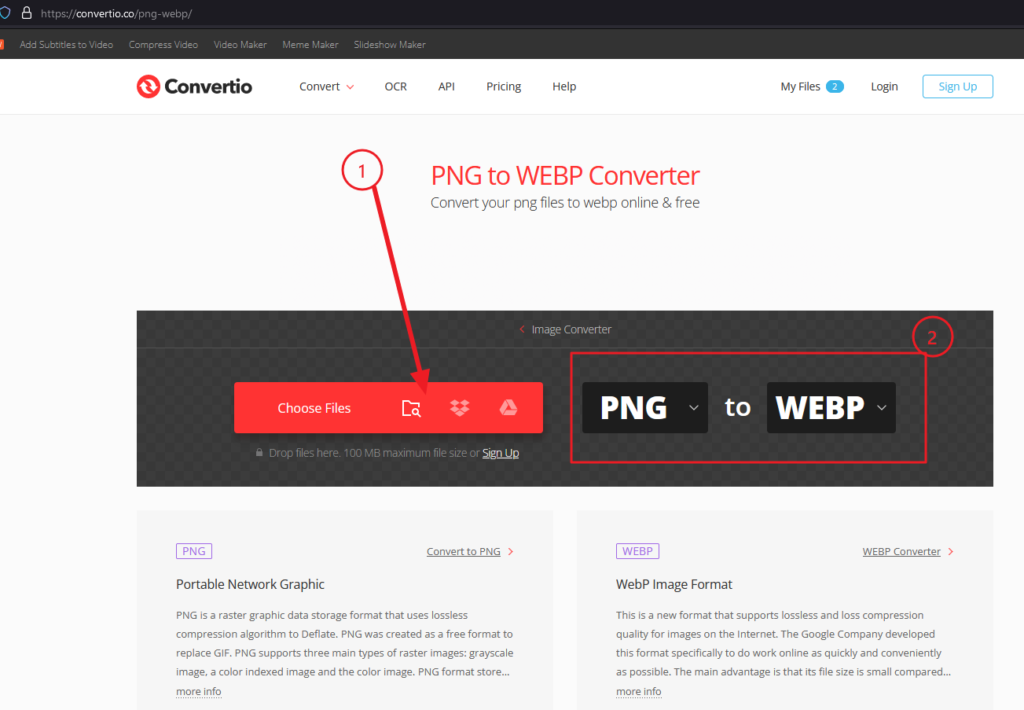Introduction
Having a strong online presence is crucial for any business to succeed in today’s fast-paced digital world. This can be achieved by increasing the visibility of your website so you can drive more traffic to it. With millions of websites competing for attention, it is crucial to implement effective SEO techniques that can help your website stand out from the crowd.
In this article, we will explore in detail, the top SEO techniques that can be quickly used to drive more traffic to your website, ultimately boosting your online visibility and attracting potential customers. These techniques will provide you with valuable insights and actionable strategies to improve your website’s search engine rankings regardless of your experience as a web marketer.
Table of Contents
1. On-Page Optimization SEO Technique
1.1 Keyword Research
Keyword research is a crucial, but most overlooked, step in optimizing your website for search engines. It involves identifying the relevant keywords and phrases that your target audience is using to search for your products or services. By understanding these keywords, you can optimize your website’s content to directly target and align with what your potential customers are looking for.
Conducting effective keyword research can effectively be broken down into two steps:
- Start by brainstorming a list of words and phrases that are relevant to your business.
- Then use keyword research tools such as Ahrefs, Google Keyword Planner, SEMRush, or Moz Keyword Explorer to expand your list and discover additional keywords that have high search volumes and low competition.
The screenshot below shows an example of Moz Pro which has a generous 30-day Trial so you can experiment with its features.
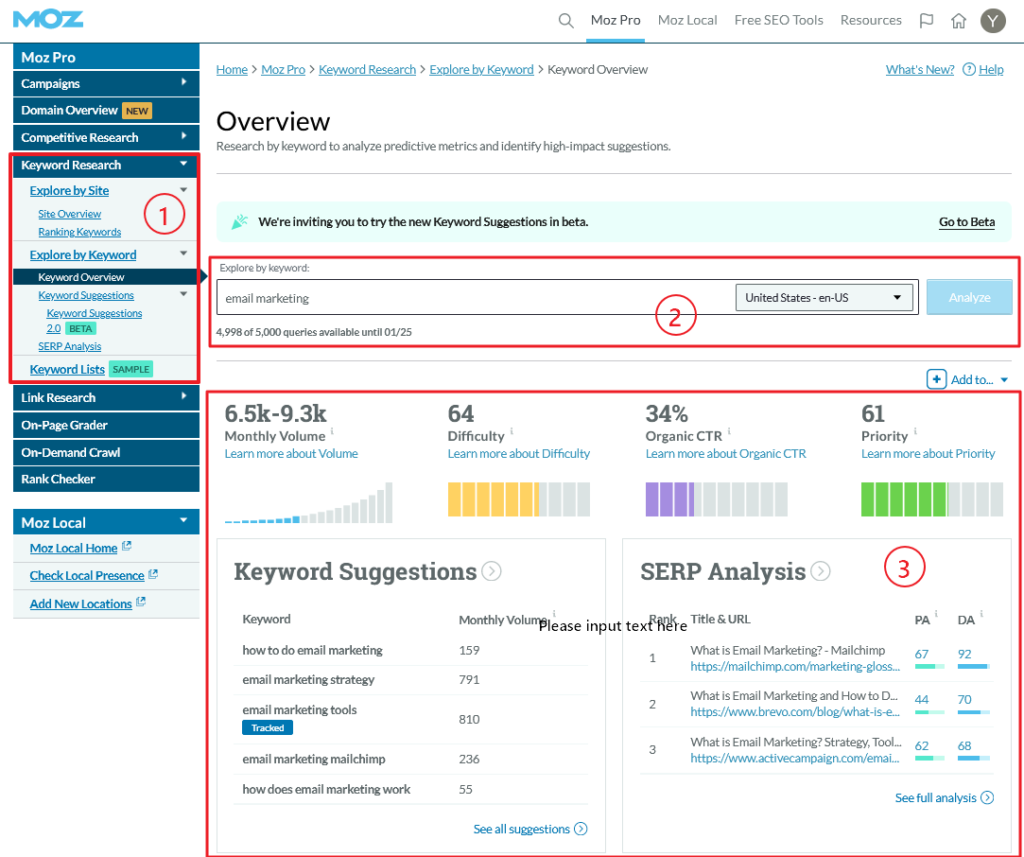
Once you have a list of keywords that you want to use, incorporate them into your website’s content. Focus on including them in your page titles, headings, meta descriptions, and throughout the body of your content. However, ensure that the keywords are used naturally and do not compromise the readability and user experience of your website. Google does not take kindly to overused keywords and may penalize your site as that is considered “keyword stuffing”.
1.2 Meta Tags Optimization
Meta tags are snippets of HTML code that provide information about a webpage to search engines and website visitors. Optimizing your meta tags can significantly impact your website’s visibility in search engine results pages (SERPs) and influence the click-through rates of your web pages.

The two most important meta tags for SEO are the title tag and the meta description tag. The title tag appears as the clickable headline in search results and should be concise, descriptive, and contain relevant keywords. The meta description tag provides a summary of the webpage and should compel users to click through to your website.
When optimizing your meta tags, make sure to include your target keywords naturally within the title tag and meta description tag. Each page on your website should have a unique title tag and meta description that accurately reflects the content of that particular page.
1.3 URL Structure Optimization
Optimizing your website’s URL structure is essential for both search engines and users. A well-structured URL can help search engines understand the content of your webpage and improve its chances of ranking higher in search results. Additionally, it can make your URLs more readable and user-friendly, which can enhance the user experience and encourage click-through rates.
When optimizing your URL structure, follow these best practices:
- Use descriptive and concise URLs that accurately represent the content of the page.
- Include relevant keywords in the URL, but avoid keyword stuffing.
- Use hyphens to separate words in the URL, as search engines consider hyphens as word separators.
- Avoid using dynamic parameters and unnecessary parameters in your URLs.
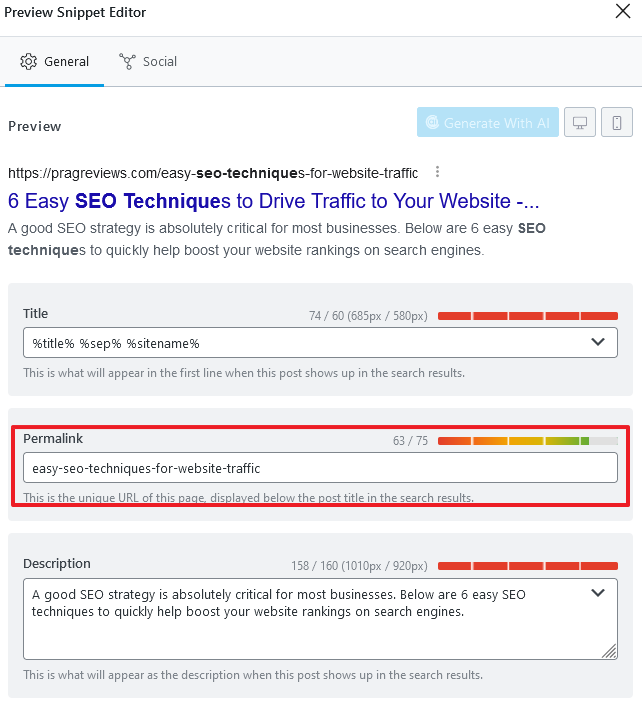
By optimizing your website’s URL structure, you can improve the visibility of your web pages in search results and make it easier for users to navigate and share your content.
Remember, on-page optimization plays a crucial role in driving more traffic to your website. By conducting thorough keyword research, optimizing your meta tags, and refining your URL structure, you can enhance your website’s visibility in search results and attract more relevant visitors.
2. Technical SEO
2.1 Website Speed Optimization
In today’s fast-paced digital world, website speed is crucial in user experience and search engine rankings. Slow-loading websites not only frustrate visitors but also negatively impact your SEO efforts.
The graphic below shows our website’s current page speeds on Mobile and Desktop after we implemented some (not all) of the steps outlined below.
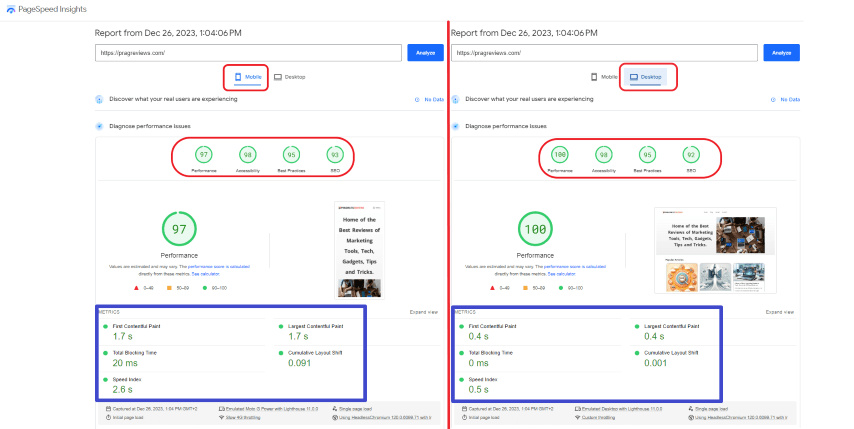
- Optimize Images: Large image files can significantly slow down your website. Compress and resize images without compromising quality to reduce their file size. One of the highly recommended file types to use for optimization is called WebP:
WebP is a modern image format that provides superior lossless and lossy compression for images on the web. Using WebP, webmasters and web developers can create smaller, richer images that make the web faster. WebP lossless images are 26% smaller in size compared to PNGs
Google.com - Below are two easy ways to optimize images:
- Use an online tool or service like Convertio. It is free but with a size limitation of 100MB if you are not logged in, but is very simple to use:
- Drag and drop (or browse for) the files to convert.

Convertio Image Converter - On the left, the source image extension should automatically match the original, but make sure the destination (on the right) is WEBP (as shown in the image above).
- Click Convert for the tool to start processing to reduce the image size
- Download the converted image and upload it.
- Use a WordPress plugin. Directly installed on your website, a plugin like Seraphinite Accelerator will not only minimize the image size, but it will also make your Javascript and CSS smaller (next bullet point). We use the free version of the plugin on the website and we highly recommend it. The setup is straightforward.
- Please note that we are not an affiliate of the product but we are making a recommendation based on the results after we applied the settings recommended for the plugin.
- Use an online tool or service like Convertio. It is free but with a size limitation of 100MB if you are not logged in, but is very simple to use:
- Minify CSS and JavaScript: Remove unnecessary characters, spaces, and line breaks from your CSS and JavaScript files. Minifying these files can help reduce their size and improve website speed.
- Enable Browser Caching: By enabling browser caching, you allow visitors’ browsers to store certain elements of your website, such as images and CSS files so that they don’t need to be reloaded on subsequent visits.
- Use a Content Delivery Network (CDN): A CDN distributes your website’s static files across multiple servers worldwide, allowing visitors to access them from the server closest to their location. This helps reduce latency and improve website speed.
- Reduce HTTP Requests: Each element on your webpage, such as images, scripts, and stylesheets, requires a separate HTTP request to load. Minimize the number of elements and combine multiple files where possible to reduce the number of requests.
2.2 Mobile-Friendly Design
With the increasing use of mobile devices, having a mobile-friendly website is essential for both user experience and SEO. Here’s how you can ensure your website is optimized for mobile devices:
- Responsive Design: Implement a responsive design that automatically adjusts the layout and content based on the user’s screen size and device. This ensures a seamless experience across different devices.
- Mobile-Friendly Navigation: Simplify your website’s navigation for mobile users. Use a hamburger menu or other mobile-friendly navigation options to make it easy for visitors to navigate your site on smaller screens.
- Readable Font Sizes: Ensure that your website’s text is legible on mobile devices. Use font sizes that are large enough to be easily read without zooming in.
- Optimize Tap Targets: Make sure your website’s buttons, links, and other interactive elements are large enough and well-spaced to be easily tapped with a finger. This prevents accidental taps and improves user experience.
2.3 XML Sitemap Creation
Creating an XML sitemap for your website helps search engines crawl and index your pages more efficiently. Here’s how you can create an XML sitemap:
- Use a Sitemap Generator: Various online sitemap generator tools are available that can automatically crawl your website and generate an XML sitemap. Enter your website’s URL, and the tool will do the rest.
- Submit the XML Sitemap: Once you have generated the XML sitemap, submit it to search engines like Google and Bing. This ensures that search engines are aware of all your website’s pages and can crawl them effectively. Below are steps to manually submit your website’s site map to Google:
- Search for Google Search Console in Google Search
- Look for the Google Search Console Tools link. Click on it.
- Click Start now.
- Follow the easy prompts to set up your site (called a property in Google Console and Google Analytics terms).

Google Search Console Sitemap - Once the setup is complete:
- Click on Sitemaps on the left sidebar (1)
- In the Add a new sitemap box, append the name of the site map to the end of your web address or URL (2)
- Click Submit (3)
- The sitemap should now appear under Submitted sitemaps (4) with the Status Code Success.
- Regularly Update the Sitemap: Whenever you add or remove pages from your website, update your XML sitemap accordingly. This helps search engines stay up-to-date with your website’s content and improves indexation.
By implementing these technical SEO techniques, you can enhance your website’s speed, mobile-friendliness, and indexability, leading to improved search engine rankings and increased traffic.
3. Content Creation and Optimization SEO Technique
3.1 High-Quality and Relevant Content
Creating high-quality and relevant content is crucial for the success of your website’s SEO strategy. When it comes to content creation, focus on providing valuable information that meets the needs and interests of your target audience. Here are some key points to consider:
- Research your audience: Understand your target audience’s demographics, preferences, and pain points. This will help you tailor your content to their specific needs and interests.
- Identify relevant topics: Conduct keyword research to identify topics that are popular and relevant to your niche. Use tools like Google Keyword Planner or SEMrush to find keywords with high search volume and low competition.
- Produce original and engaging content: Avoid duplicating content from other websites. Instead, create unique and informative articles, blog posts, or videos that captivate your audience’s attention.
- Use headlines and subheadings: Organize your content using clear and descriptive headlines and subheadings. This helps both readers and search engines understand the structure and relevance of your content.
- Incorporate multimedia elements: Enhance your content by including images, videos, infographics, or slideshows. This not only makes your content visually appealing but also improves engagement and sharing potential.
By consistently producing high-quality and relevant content, you can establish your website as a trustworthy source of information, attracting more organic traffic and improving your overall SEO performance.
3.2 Keyword Optimization
Keyword optimization plays a vital role in driving targeted traffic to your website. By strategically incorporating relevant keywords into your content, you can increase its visibility in search engine results. Consider the following tips for effective keyword optimization:
- Perform keyword research: Use keyword research tools to identify relevant keywords that align with your content and target audience. Look for keywords with high search volume and low competition to maximize your chances of ranking higher.
- Include keywords in title tags and meta descriptions: Optimize your title tags and meta descriptions by including targeted keywords. These elements appear in search engine results, so make them compelling and relevant to attract clicks from users.
- Use keywords naturally in your content: Avoid keyword stuffing, which can negatively impact your SEO. Instead, incorporate keywords naturally throughout your content, including in headings, subheadings, and body paragraphs.
- Optimize images with alt text: When using images, remember to optimize them with descriptive alt text that includes relevant keywords. This helps search engines understand the context and improves accessibility for visually impaired users.
- Monitor keyword performance: Regularly analyze your keyword performance using tools like Google Analytics or Moz. This allows you to identify which keywords are driving traffic and conversions, helping you refine your optimization strategy.
By implementing effective keyword optimization techniques, you can increase your website’s visibility in search engine results and attract more qualified traffic.
3.3 Internal and External Linking
Internal and external linking are essential components of a well-optimized website. By strategically incorporating links into your content, you can enhance user experience, improve website navigation, and boost your SEO efforts. Consider the following practices:
- Internal linking: Link relevant pages or blog posts within your website to provide users with additional information and encourage them to explore more of your content. Internal links also help search engines crawl and index your website more effectively.
- Anchor text optimization: Use descriptive and keyword-rich anchor text when creating internal links. This helps search engines understand the context and relevance of the linked page.
- External linking: Linking to reputable external websites can add credibility to your content and improve user experience. When linking externally, choose authoritative sources that provide valuable information related to your content.
- Earn backlinks: Focus on creating high-quality content that naturally attracts backlinks from other websites. Backlinks from reputable sources can significantly improve your website’s authority and search engine rankings.
- Regularly check for broken links: Broken links can harm your website’s user experience and SEO. Use tools like Google Search Console or Broken Link Checker to identify and fix any broken links on your website.
By implementing a strong internal and external linking strategy, you can improve your website’s authority, enhance user experience, and increase your chances of ranking higher in search engine results.
4. User Experience SEO Technique
User experience plays a crucial role in determining the success of a website. A positive user experience not only keeps visitors engaged but also encourages them to explore further, ultimately driving more traffic to your website. In this section, we will discuss some key elements of user experience that can significantly impact your website’s traffic.
4.1 Responsive Web Design
In today’s mobile-dominated world, having a responsive web design is essential. A responsive website adapts to different screen sizes and devices, providing an optimal viewing experience for users. When your website is mobile-friendly, it not only improves user experience but also positively affects your search engine rankings.
Search engines like Google prioritize mobile-friendly websites in their search results, making it easier for users to find and access your website. Additionally, responsive web design eliminates the need for users to zoom in or scroll horizontally, ensuring a seamless browsing experience. By implementing responsive web design, you can attract more mobile users and increase your website traffic.
4.2 Easy Navigation
Navigating through a website should be intuitive and effortless for users. If visitors find it challenging to locate information or navigate from one page to another, they are likely to leave your website and look for alternatives. To prevent this, it is crucial to prioritize easy navigation.
The general rule of thumb is that “your visitors should be able to reach any page on your website from the home page within 3 clicks”.
Ensure that your website has a clear and well-structured menu that allows users to quickly find the information they are seeking. Use descriptive labels for each menu item and organize the content logically. Additionally, consider implementing a search functionality that enables users to search for specific content within your website.
By providing easy navigation, you enhance the user experience, encourage visitors to explore more pages, and ultimately increase the time they spend on your website. This, in turn, positively impacts your website’s traffic and engagement metrics.
4.3 Decrease Bounce Rate
Bounce rate refers to the percentage of visitors who leave your website after viewing only one page. A high bounce rate indicates that visitors did not find what they were looking for or were dissatisfied with their experience on your website. Decreasing the bounce rate is crucial for improving user experience and driving more traffic.
To decrease the bounce rate, focus on delivering relevant and engaging content that matches users’ search intent. Ensure that your website’s landing pages are optimized for specific keywords and provide valuable information related to the search query. Additionally, pay attention to the loading speed of your website, as slow-loading pages can significantly increase the bounce rate.
By understanding your target audience and catering to their needs, you can create a website that captivates visitors and encourages them to explore more. By decreasing the bounce rate, you can improve user experience, increase the average time spent on your website, and ultimately drive more traffic.
Implementing responsive web design, ensuring easy navigation, and decreasing the bounce rate are all essential aspects of enhancing user experience. By prioritizing user experience, you can create a website that not only attracts more traffic but also retains and engages visitors, leading to increased conversions and success online.
5. Backlink Building SEO Technique
When it comes to improving your website’s search engine optimization (SEO) and driving more traffic, backlink building is an essential technique to consider. Backlinks are links from other websites that point back to your site, indicating its credibility and authority to search engines. Here are three effective strategies for building backlinks:
5.1 Guest Blogging
Guest blogging is a fantastic way to not only generate backlinks but also establish yourself as an industry expert and reach a wider audience. The process involves writing high-quality content for other websites in your niche and including a link back to your website within the article or author bio.
To get started with guest blogging, identify authoritative websites in your industry that accept guest posts. Reach out to them with a well-crafted pitch, highlighting your expertise and suggesting relevant topics you can write about. Once your pitch is accepted, create engaging and informative content that provides value to the readers. Include a link back to your website in a natural and non-promotional way. This will not only drive traffic but also improve your website’s visibility in search engine results.
5.2 Influencer Outreach
Influencer outreach is another effective strategy for building backlinks and increasing your website’s visibility. Influencers are individuals or brands with a significant following and influence in your industry. By collaborating with influencers and getting them to mention or link to your website, you can tap into their audience and drive targeted traffic.
Start by identifying relevant influencers in your niche. Look for those who align with your brand values and have an engaged audience. Reach out to them via email or social media and propose a collaboration or partnership. This could involve creating content together, such as guest posting on their blog or featuring them in an interview on your website. When influencers share or link to your content, it not only drives traffic but also boosts your website’s credibility and authority in the eyes of search engines.
5.3 Social Media Promotion
Social media platforms offer an excellent opportunity to promote your content and build backlinks. Leverage your social media presence to share your website’s content, engage with your audience, and encourage them to share your posts and link back to your website.
Create compelling and shareable content that resonates with your target audience. This could include informative blog posts, engaging videos, or visually appealing infographics. Make sure to include social sharing buttons on your website, allowing visitors to easily share your content on their social media profiles.
Engage with your followers by responding to comments, asking questions, and initiating discussions. Encourage them to share your content by offering incentives or running social media contests. The more your content gets shared and linked to, the more backlinks you’ll generate, leading to increased traffic and improved SEO.
In conclusion, backlink building is an essential SEO technique to drive more traffic to your website. By incorporating guest blogging, influencer outreach, and social media promotion into your overall SEO strategy, you can improve your website’s visibility, and credibility, and ultimately attract a larger audience.
6. Analytics and Monitoring
To effectively drive more traffic to your website and optimize your SEO efforts, it is crucial to have a solid understanding of your website’s performance. Analytics and monitoring tools provide valuable insights into user behavior, traffic sources, and website performance metrics. By leveraging these tools, you can make data-driven decisions to improve your SEO strategy and enhance the overall user experience. Here are three important analytics and monitoring techniques to consider:
6.1 Google Analytics
Google Analytics is an indispensable tool for website owners and SEO professionals. It provides a comprehensive overview of your website’s performance, enabling you to track key metrics such as the number of visitors, traffic sources, bounce rate, and conversion rate. By analyzing this data, you can identify which pages are performing well and which ones require optimization. Additionally, Google Analytics offers valuable insights into user demographics, allowing you to tailor your content and marketing efforts to target specific audiences effectively.
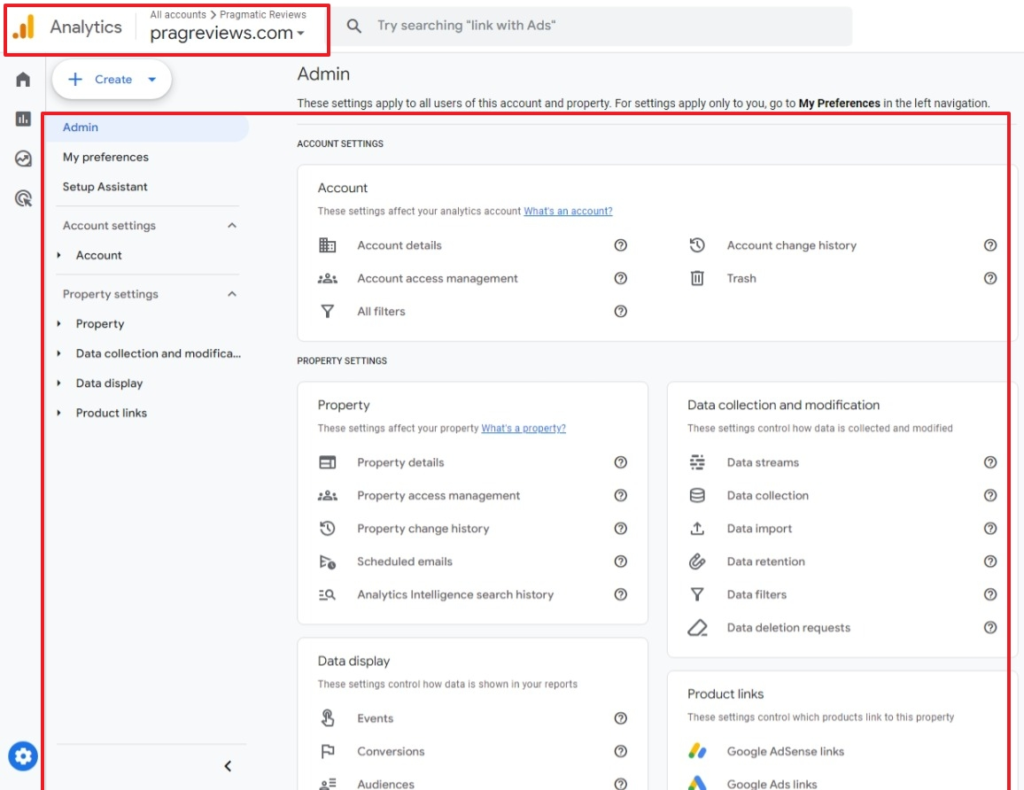
6.2 Search Console
Google Search Console, formerly known as Google Webmaster Tools, is another essential tool for monitoring your website’s SEO performance. It provides valuable information on how Google perceives your site, including indexing status, crawl errors, and search queries that drive traffic to your website. By regularly reviewing the data in the Search Console, you can identify and fix any technical issues that may be affecting your site’s visibility in search results. Furthermore, Search Console allows you to submit your sitemap, request indexing of new or updated pages, and monitor your website’s mobile usability, ensuring optimal performance across different devices.
6.3 Regular Performance Analysis
Performing regular performance analysis is crucial for maintaining a successful SEO strategy. By analyzing various metrics like page load speed, bounce rate, and conversion rate, you can identify areas for improvement and make data-driven decisions to enhance user experience. Tools like Google Analytics and Search Console provide comprehensive performance data, but it’s also important to monitor other metrics such as keyword rankings, backlink profiles, and social media engagement. By consistently monitoring and analyzing these metrics, you can identify trends, spot potential issues, and adjust your SEO techniques accordingly.
In conclusion, analytics and monitoring are essential components of any successful SEO strategy. By utilizing tools like Google Analytics and Search Console, as well as regularly analyzing performance metrics, you can gain valuable insights into your website’s performance and make informed decisions to drive more traffic and improve your overall SEO efforts.
In conclusion, implementing effective SEO techniques is crucial for driving more traffic to your website. By ensuring your website is optimized for search engines, utilizing keywords strategically, and creating high-quality and relevant content, you can improve your website’s visibility and attract more organic traffic. Additionally, incorporating backlinks, optimizing your website’s speed, and utilizing social media platforms can further enhance your SEO efforts. Remember, SEO is an ongoing process that requires continuous monitoring and adjustments to stay ahead of the competition and maintain a steady flow of traffic to your website. By following the top SEO techniques discussed in this article, you can increase your website’s visibility, reach a broader audience, and ultimately achieve your online goals.
Read our other articles in the blog to learn more tips and tricks about email marketing-related topics like this one and this one.


